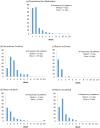Examination of Early Functional Recovery After ACL Reconstruction: Functional Milestone Achievement and Self-Reported Function
- PMID: 29863963
- PMCID: PMC6044123
- DOI: 10.1177/1941738118779762
Examination of Early Functional Recovery After ACL Reconstruction: Functional Milestone Achievement and Self-Reported Function
Abstract
Background: Few studies have documented early functional recovery after anterior cruciate ligament (ACL) reconstruction.
Purpose: To quantify the time to early functional milestone achievement and change in function over 12 weeks after ACL reconstruction and to identify demographic characteristic predictors of the outcomes.
Study design: Prospective, longitudinal, observational study.
Level of evidence: Level 4.
Methods: A total of 182 patients (95 females, 87 males; mean ± SD age, 28 ± 12 years; mean ± SD body mass index [BMI], 25 ± 4 kg/m2) who received primary, unilateral, ACL reconstruction were included. Testing occurred before surgery as well as 1, 2, 4, 8, and 12 weeks postsurgery. Outcomes included demographic characteristics, self-reported functional milestone achievements and responses on the Short Musculoskeletal Function Assessment (SMFA) questionnaire. Time to functional milestone achievement was calculated, and patients were categorized into "faster" or "prolonged" recovery groups based on the median value. Longitudinal change in SMFA subscale scores (daily activities and mobility) as well as demographic predictors of functional recovery group assignment and postsurgical change in SMFA subscale scores were examined.
Results: Median time for discontinuing narcotic pain medication was 9 days, while that for discontinuing crutches was 15 days. Time to return to work occurred at a median of 11 days, return to school at 7 days, and return to driving at 11 days. Both SMFA subscale scores significantly decreased (improved) over time, with the greatest change occurring between 1 and 4 weeks postsurgery. The demographic predictor of faster functional recovery for discontinuation of narcotic pain medication was surgery with allograft; those for return to work were higher age, male sex, decreasing BMI, and sedentary/light occupational demand; and those for return to driving were higher age, male sex, and surgery on the left side of the body.
Conclusion: Functional recovery occurs rapidly over the first month after ACL reconstruction for most patients. Nonmodifiable demographic characteristics may influence recovery time for specific functional milestones.
Clinical relevance: Results can be used to counsel patients on early functional recovery after ACL reconstruction.
Keywords: ACL; outcomes; rehabilitation; return to driving; return to work.
Conflict of interest statement
The authors report no potential conflicts of interest in the development and publication of this article.
Figures
References
-
- Ahmad CS. The incidence of patellofemoral osteoarthritis and associated findings 7 years after anterior cruciate ligament reconstruction with a bone–patellar tendon–bone autograft. Am J Sports Med. 2001;29:678-679. - PubMed
-
- Ahn JH, Kim JG, Wang JH, Jung CH, Lim HC. Long-term results of anterior cruciate ligament reconstruction using bone–patellar tendon–bone: an analysis of the factors affecting the development of osteoarthritis. Arthroscopy. 2012;28:1114-1123. - PubMed
-
- Ajuied A, Wong F, Smith C, et al. Anterior cruciate ligament injury and radiologic progression of knee osteoarthritis: a systematic review and meta-analysis. Am J Sports Med. 2014;42:2242-2252. - PubMed
-
- Ardern CL, Taylor NF, Feller JA, Whitehead TS, Webster KE. Psychological responses matter in returning to preinjury level of sport after anterior cruciate ligament reconstruction surgery. Am J Sports Med. 2013;41:1549-1558. - PubMed
-
- Ardern CL, Webster KE, Taylor NF, Feller JA. Return to sport following anterior cruciate ligament reconstruction surgery: a systematic review and meta-analysis of the state of play. Br J Sports Med. 2011;45:596-606. - PubMed
Publication types
MeSH terms
LinkOut - more resources
Full Text Sources
Other Literature Sources
Medical
Research Materials



